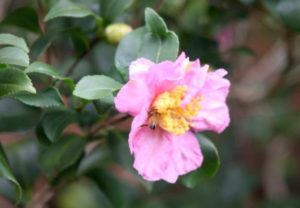

by Lydia Holley January 20, 2020
If you have a spot to place a camellia in your garden, I recommend doing so. Camellias are treasured by gardeners because they bloom in the winter months. Camellias like to be planted
in summer shade and winter sun. Pay attention now to which areas of your garden are in sun. In the summer, look at those areas again – are they in shade? By observing the differences in sun and shade patterns, you will know where a camellia might like to be planted.
The two most popular types of camellias are japonicas and sasanquas. Japonicas are usually
quite large, growing to the size of a small tree. They generally have large, glossy leaves. Most japonicas bloom in late winter or early spring. When spent, the bloom from a japonica falls off in its entirety. Because of this trait, you can float japonica blooms in a shallow bowl of water.
Sasanquas usually bloom in the fall or early winter. Although some sasanquas can grow 15 to 20 feet tall, there are some that can be kept as short as three feet. They usually have smaller and duller leaves than the japonicas, and will tolerate more sun. Sasanqua blooms fall petal by petal.
Camellias are also evergreen, so they add winter interest even when they are not in bloom. They look nice as a focal point, in pairs, in pots, or planted as a hedge. The key to having as many blooms as possible is to water consistently during the summer months. They may drop their buds when they are first planted or if moved, but you should be rewarded with blooms the following year.
When the weather is cold, it is a joy to see camellias in bloom. Plant them where you can see them from a window, and you can daydream about sunny days and warm temperatures.
For more information, call 903-675-6130, email hendersonCMGA@gmail.com.
Follow us on Facebook: https://www.facebook.com/HCmastergardener.